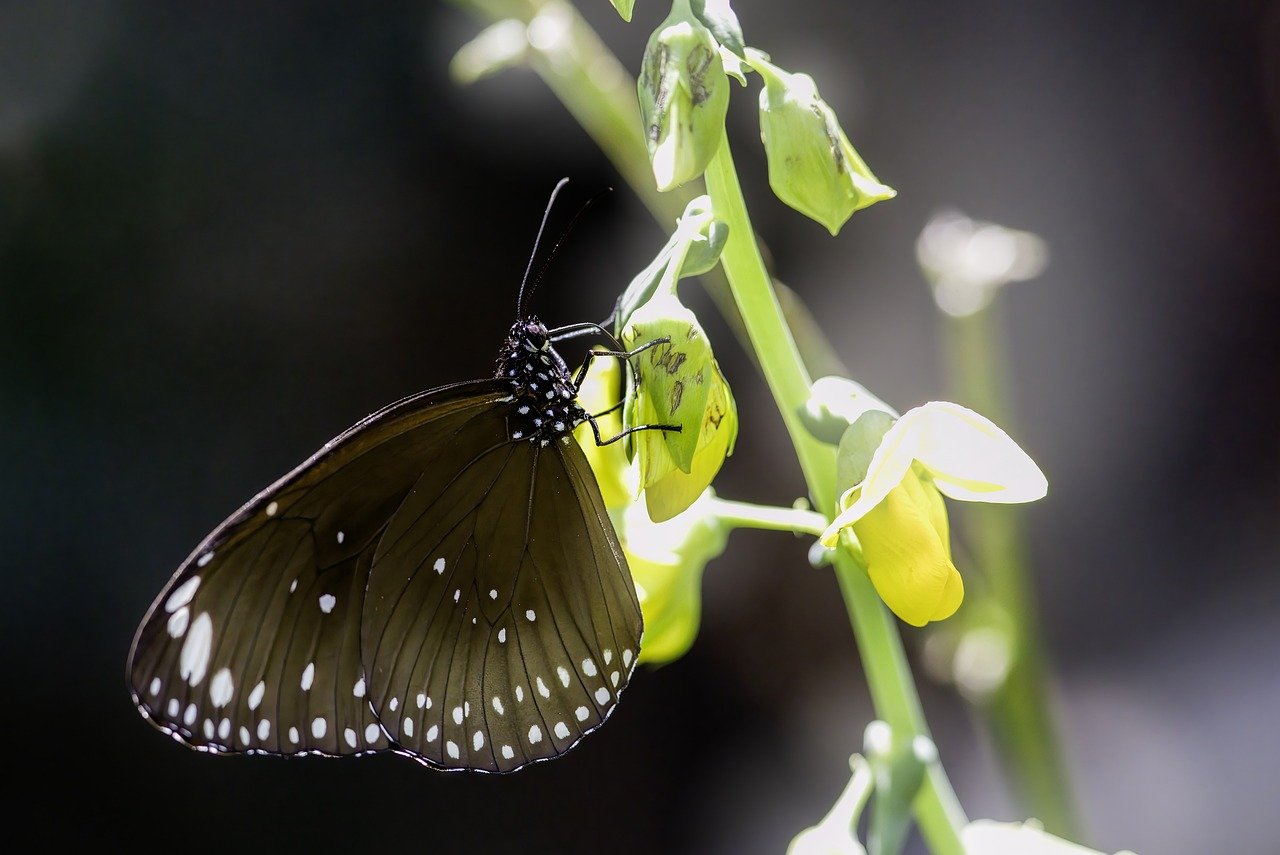The Common Crow (Euploea core), also known as the Common Indian Crow, is a large butterfly belonging to the Danaid group of the Nymphalidae family. Known for its dark, glossy wings with distinctive white markings, this species is widespread across South Asia, Southeast Asia, and parts of Australia. It’s well-known for its strong, graceful flight and is often seen fluttering in gardens, parks, and forested areas.
Appearance
- Wingspan: Ranges from 85 to 95 millimeters.
- Coloration:
- Upperside: The wings are dark brown to black, with a purplish or bluish gloss in bright light. The forewings and hindwings have small, scattered white spots, particularly along the margins.
- Underside: The wings are a paler brown with a more prominent pattern of white spots, making the butterfly easily recognizable when at rest.
- Sexual Dimorphism: Males and females look very similar, although females may be slightly larger.
Habitat
- Distribution: Found widely throughout India, Sri Lanka, Myanmar, Thailand, Malaysia, Indonesia, and extending to parts of northern Australia. It is one of the most common butterflies in these regions.
- Preferred Habitats: Inhabits a wide range of environments, including gardens, agricultural areas, scrublands, mangroves, open woodlands, and urban areas. They are adaptable and thrive in both moist and dry conditions.
Behavior
- Feeding: Adults feed on nectar from a variety of flowers such as Lantana, Ixora, and other nectar-rich blooms. Caterpillars primarily feed on plants from the milkweed family (Apocynaceae and Asclepiadaceae), which provide them with toxic compounds that deter predators.
- Flight Pattern: Has a slow, purposeful flight, often gliding close to the ground or vegetation. Common Crows are known for their leisurely flying style, which is a warning to predators of their toxicity.
- Mimicry and Defense: The butterfly is part of the “milkweed butterfly” complex, using Batesian and Müllerian mimicry to enhance its survival. Its resemblance to other toxic butterflies and its own acquired toxins from milkweed make it less likely to be eaten by birds and other predators.
Life Cycle
- Egg: Eggs are laid singly on the underside of host plant leaves.
- Larva (Caterpillar): The caterpillars are striking, with black bodies marked with white and yellow bands, and they possess long fleshy tentacles on their heads and tails. They feed on toxic host plants, accumulating the toxins to use as a defense mechanism.
- Pupa (Chrysalis): The pupa is smooth and green, with gold spots. It often attaches itself to twigs, leaves, or other surfaces near the host plant.
- Adult: Emerges after about two weeks, ready to mate and continue the cycle.
Ecological Importance
- Pollination: Common Crows are active pollinators, visiting a wide range of flowering plants.
- Food Web Role: As unpalatable prey, they play a critical role in local food webs, helping regulate predator populations. Their presence is also an indicator of healthy ecosystems, particularly where their host plants are available.
Conservation Status
- Not Threatened: The Common Crow butterfly is abundant and widespread, showing a robust ability to adapt to different habitats, including urban environments. However, like all species, it can be impacted by habitat destruction, pesticide use, and climate change.
The Common Crow (Euploea core) is a resilient butterfly that is admired for its beauty, adaptability, and role in local ecosystems. Its presence in various habitats makes it a familiar sight for nature lovers across its range.
Visited 119 times, 38 visit(s) today
Views: 213
Subscribe to the newsletter:
